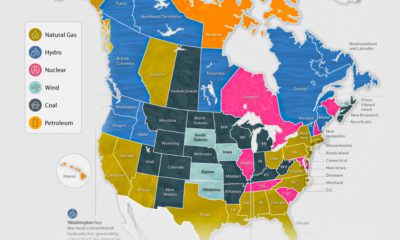Energy is a touchy subject, and billions of dollars are spent each year to campaign on issues surrounding fossil fuels, renewable energy funding, pipelines, environmental concerns, and fracking. With so much at stake, special interest groups, governments, and corporations are constantly engaged to “win the war” on information by putting their own spin on facts. This creates a tangled web that is tough to navigate for any inquisitive person.
Energy Sources 101
Well, we have good news – recently, we came across a pretty nifty Youtube channel that is visual, intuitive, and fact-driven. It focuses on providing introductory information on different energy sources. The Student Energy Movement aims to be a “universal entry point for learning about the energy system” by delivering accurate and unbiased energy information. Here’s some of the videos we thought were worthwhile, highlighting both the pros and cons of different energy sources:
Hydro
Explains how hydro power works, but also touches on pumped hydro (energy storage) and pros/cons.
Nuclear
The difference between fission and fusion, as well as the benefits and drawbacks of nuclear energy.
Oil
Explains how oil is formed, and also how it is processed and transported.
Natural Gas
Explains wet and dry gas, as well as how gas is extracted and processed.
Solar
Discusses both photovoltaic and solar thermal. For more information on how each of those types work, go here and here.
Also, here’s links to additional videos on energy sources such as geothermal, biofuels, coal, wind, and tidal.
Other Energy Topics
But that’s not all – the organization has also produced great videos on topics like fracking, in situ oil sands production, liquefied natural gas, and hydrogen. Here are those videos in case you want to dive deeper into other energy topics:
Hydraulic Fracturing
Explains how “fracking” works.
In Situ Oil Sands Production
An alternative to mining in the oil sands, this video show how in situ production works.
Liquefied Natural Gas
This video shows how natural gas is liquefied, and transported to other markets.
Hydrogen
Examines the potential of hydrogen, along with the issues surrounding it. Also explains how fuel cells work.
on
#1: High Reliability
Nuclear power plants run 24/7 and are the most reliable source of sustainable energy. Nuclear electricity generation remains steady around the clock throughout the day, week, and year. Meanwhile, daily solar generation peaks in the afternoon when electricity demand is usually lower, and wind generation depends on wind speeds.As the use of variable solar and wind power increases globally, nuclear offers a stable and reliable backbone for a clean electricity grid.
#2: Clean Electricity
Nuclear reactors use fission to generate electricity without any greenhouse gas (GHG) emissions.Consequently, nuclear power is the cleanest energy source on a lifecycle basis, measured in CO2-equivalent emissions per gigawatt-hour (GWh) of electricity produced by a power plant over its lifetime. The lifecycle emissions from a typical nuclear power plant are 273 times lower than coal and 163 times lower than natural gas. Furthermore, nuclear is relatively less resource-intensive, allowing for lower supply chain emissions than wind and solar plants.
#3: Stable Affordability
Although nuclear plants can be expensive to build, they are cost-competitive in the long run. Most nuclear plants have an initial lifetime of around 40 years, after which they can continue operating with approved lifetime extensions. Nuclear plants with lifetime extensions are the cheapest sources of electricity in the United States, and 88 of the country’s 92 reactors have received approvals for 20-year extensions. Additionally, according to the World Nuclear Association, nuclear plants are relatively less susceptible to fuel price volatility than natural gas plants, allowing for stable costs of electricity generation.
#4: Energy Efficiency
Nuclear’s high energy return on investment (EROI) exemplifies its exceptional efficiency. EROI measures how many units of energy are returned for every unit invested in building and running a power plant, over its lifetime. According to a 2018 study by Weissbach et al., nuclear’s EROI is 75 units, making it the most efficient energy source by some distance, with hydropower ranking second at 35 units.
#5: Sustainable Innovation
New, advanced reactor designs are bypassing many of the difficulties faced by traditional nuclear plants, making nuclear power more accessible.
Small Modular Reactors (SMRs) are much smaller than conventional reactors and are modular—meaning that their components can be transported and assembled in different locations. Microreactors are smaller than SMRs and are designed to provide electricity in remote and small market areas. They can also serve as backup power sources during emergencies.
These reactor designs offer several advantages, including lower initial capital costs, portability, and increased scalability.
A Nuclear-Powered Future
Nuclear power is making a remarkable comeback as countries work to achieve climate goals and ultimately, a state of energy utopia. Besides the 423 reactors in operation worldwide, another 56 reactors are under construction, and at least 69 more are planned for construction. Some nations, like Japan, have also reversed their attitudes toward nuclear power, embracing it as a clean and reliable energy source for the future. CanAlaska is a leading exploration company in the Athabasca Basin, the Earth’s richest uranium depository. Click here to learn more now. In part 3 of the Road to Energy Utopia series, we explore the unique properties of uranium, the fuel that powers nuclear reactors.





























